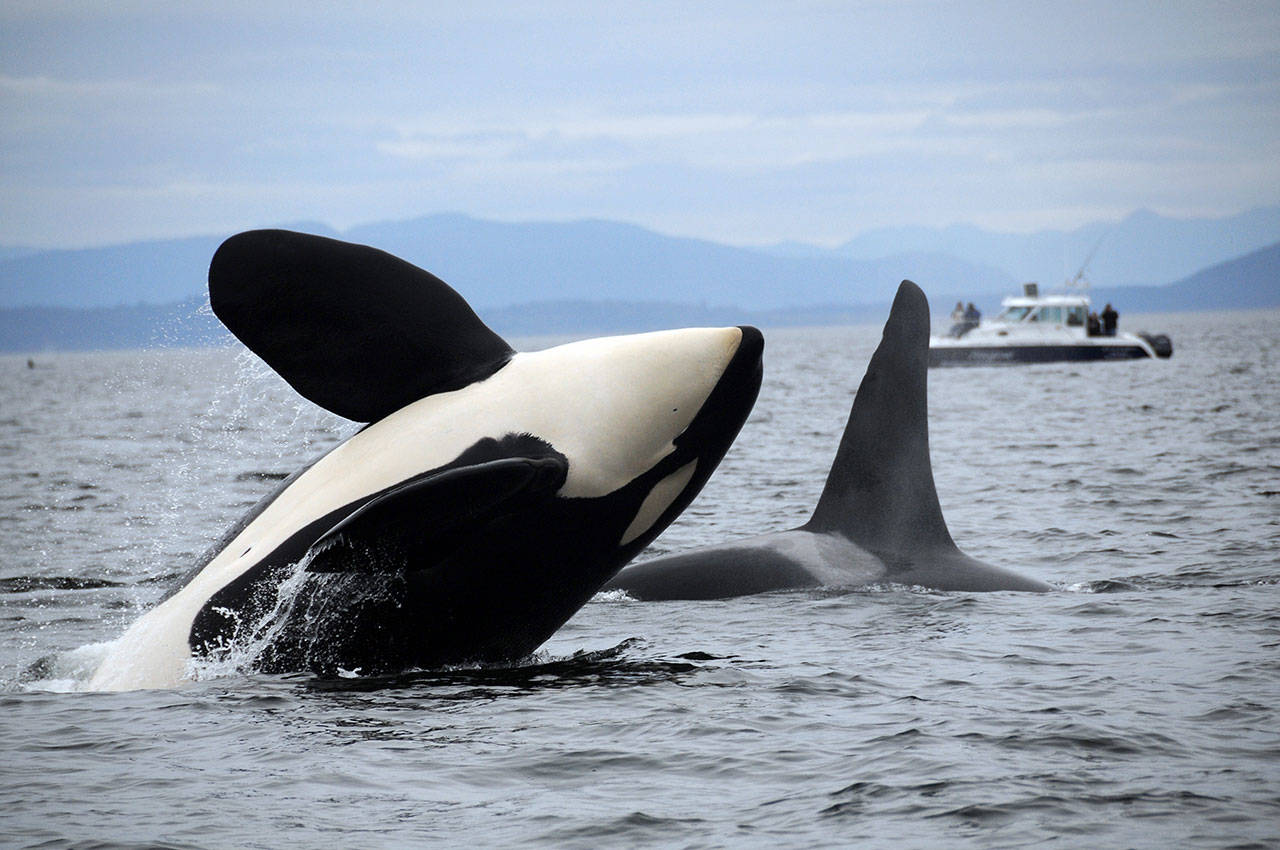The Associated Press
SEATTLE — Breaking an unprecedented run of days this summer without frequenting their home waters, J, K and even possibly L pod southern resident orcas were recently seen on the west side of San Juan Island.
The Seattle Times reports that the endangered orcas had not been here this summer, and there was one visit by the J pod, in a brief lap around San Juan Island one day in early May. They immediately left.
However on Friday the Canadian Department of Fisheries reported that members of all three pods, J, K and L, were seen on the West Coast of Vancouver.
And Ken Balcomb, founding director of the Center for Whale Research, emailed the Times on Friday morning and said: “J and K and maybe some L off my house in Haro Strait now.”
Still, the whales’ scarcity in what has long been their core summer habitat in the inland waters of the Salish Sea between the U.S. and Canada has scientists scrambling, with research scheduled but their star subjects nowhere in sight.
Yet whale watch tour operators are having one of their best years ever.
Sightings of transient orcas — or Bigg’s killer whales — have reached unprecedented numbers, humpbacks are enjoying a spectacular comeback and gray whales, seals and sea lions also are keeping the tourists coming.
At the root of it all is food.
Transients are feasting on abundant harbor seals, rebounded in number since they were protected from hunting by the 1972 Marine Mammal Protection Act, which similarly has benefited other protected marine mammals. Their resurgence is one of the great conservation successes of our time.
However, a bad year for chinook salmon, the southern residents’ primary food, particularly in the Fraser River, is thought to be driving the southern residents away this summer in search of sustenance.
While the resident orca dearth is unprecedented, it is not unexpected, researchers say. It’s consistent with a longer-term trend.
Ken Balcomb, of the Center for Whale Research, is charged by the National Oceanic and Atmospheric Administration with keeping a current photo identification catalog and population statistics on the southern residents. “For the past 10 years, I have been reporting that the trend in [southern resident killer whale] occupancy of these inshore waters is decreasing, and we are going to have to gear up for more work in the western Strait of Juan de Fuca and along the coast.”
Balcomb said he also has seen similar trends in Puget Sound, with the southern residents rarely coming around anymore except for chum runs in the autumn and winter.
“There is simply no reason for them to come into inshore waters unless they are following significant runs of salmon,” he said.
Brad Hanson, a research biologist with the NOAA’s Northwest Fisheries Science Center in Seattle, has for the last 15 years spent several weeks in June surveying the southern residents in the waters of the San Juan Islands. But he was skunked this year despite two weeks in the field in the last month that included a run toward the coast in the Strait of Juan de Fuca after Canadian colleagues reported seeing the southern residents off Vancouver Island. Bad weather turned the U.S. survey crew back.
Neah Bay is starting to look like a better base for tracking the whales than Friday Harbor, Hanson said.
Meanwhile, the Bigg’s are being seen plenty.
Monika W. Shields with her co-authors in a December 2018 paper reported record sightings of Bigg’s killer whales in the inland waters of the Salish Sea. The transients also are taking a big bite out of the local seal population, Shields and her co-authors reported, with the transients in the Salish Sea eating more than 1,000 seals in 2017 alone.
Their avid predation must be considered as salmon managers mull killing seals to protect declining salmon runs, the authors wrote. Seal populations have actually begun to level off, and even decline — while the population of Bigg’s killer whales has doubled since 1990, according to the paper.
Jeff Friedman, owner of Maya’s Legacy Whale Watching and U.S. President for the Pacific Whale Watch Association, could have told you that.
His customers this week saw dozens of Bigg’s killer whales, including families with multiple babies, and often witness epic open sea orca takedowns of seals and sea lions, Friedman said. In one recent encounter, the sea-mammal eating orcas were tossing the pelt of a Stellar sea lion in the air — all that was left of it — seemingly just for fun.
“It’s incredible to see,” Friedman said. “You really get a sense of their power and coordination, you really, really get that you are looking at an apex predator.
“We have gotten so used to the sad story of the southern residents, we forget there are animals that are doing really well.”

